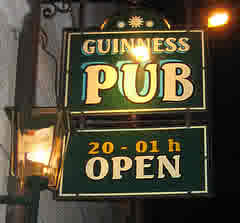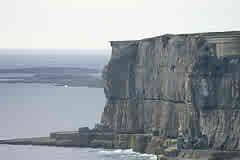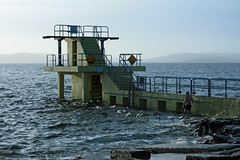Being a Tourist on Inishmore
 Wednesday, April 7, 2010 at 8:00AM |
Wednesday, April 7, 2010 at 8:00AM |  8 Comments
8 Comments The post to follow is part of a series of posts of my honest opinion of my time on Inishmore, however it should be noted that some of the expenses of this trip were waived or paid for by the Aran Island Hotel and the tourism board for the Aran Islands. Don’t hate me for taking free stuff and I promise, if I didn’t love the island, I wouldn’t write nice things about it.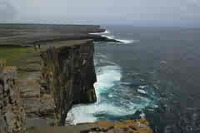 by jmenard48When I came to Inishmore, my only real priority was to immerse myself in the Irish language and culture for a bit. Fortunately, I was kidnapped by James (aka “Blue”) who works for the Aran Island Hotel and who promised me an amazing day of site seeing. Our day started early (as early as I could muster: 11) at the Aran Island Hotel where I was greeted and shown around even though the hotel doesn’t open until April. The hotel looks simple enough from the outside, but is absolutely amazing on the inside. Adorned with rich dark wood paneling and vibrant colored decorations (including beautiful stained glass doors), it was love at first site. The hotel boast a huge banquet hall and conference room and an even bigger bar room with extensive bar space, loads of tables and stools and a real Irish feel. They have live music from either locals or mainland Irish acts shipped over for special occasions. I can tell that this place is a blast when the room is full. I had originally planned on staying at the hotel while I was on Inishmore but because I decided to come in low season, they pointed me towards Seacrest B&B instead.
by jmenard48When I came to Inishmore, my only real priority was to immerse myself in the Irish language and culture for a bit. Fortunately, I was kidnapped by James (aka “Blue”) who works for the Aran Island Hotel and who promised me an amazing day of site seeing. Our day started early (as early as I could muster: 11) at the Aran Island Hotel where I was greeted and shown around even though the hotel doesn’t open until April. The hotel looks simple enough from the outside, but is absolutely amazing on the inside. Adorned with rich dark wood paneling and vibrant colored decorations (including beautiful stained glass doors), it was love at first site. The hotel boast a huge banquet hall and conference room and an even bigger bar room with extensive bar space, loads of tables and stools and a real Irish feel. They have live music from either locals or mainland Irish acts shipped over for special occasions. I can tell that this place is a blast when the room is full. I had originally planned on staying at the hotel while I was on Inishmore but because I decided to come in low season, they pointed me towards Seacrest B&B instead.
Seacrest is a super cute bed and breakfast with a great location just off the main drag leading from the docks up to the top of the hill and less than a 5 minute walk from the ferry port. The room was comfortable, clean and quiet, which was just what I needed. My room also boasted a mounted television which I definitely watched considering I haven’t watched television in… who knows how long. The best part of Seacrest for me though, was the amazing full Irish breakfast that was waiting for me when I woke up after a long night of drinking. My first course was muesli, cornflakes, yogurt and fruit. Of course I had a large glass of orange juice and tea to go with it. Second course were generous portions of bacon, sausage, eggs and toast. I felt like a million dollars after I ate. And I was glad for the added energy as I had an exhausting day of semi-hung-over sightseeing to do.
I met Blue at a pub and over a couple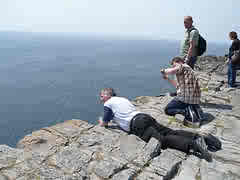 by celesteh of glasses of cider he offered to spend a day driving me around the island to show me all there is to see. We started the day by driving up the incredibly steep hill up to Dún Aonghasa which is an old three walled fort on the west side of the island. Three wall forts have three walls (obvi) but the less obvious part is why, unless you’re looking at it. The third “wall” of protection is the sheer dropoff of a 400 foot cliff. The fort had several layers of walls, with various modes of protection dividing them. The first was a series of rocks piled up loosely with their sharp ends pointing up meant to stop any mounted attack, the second, a ditch dug around a taller wall meant to stop people. The fortress truly was an amazing site to see and I spent a good hour just sitting on the edge of the cliffs marveling at the long drop to the water. I didn’t feel as vulnerable as I had the day before just a bit farther south because these cliffs were a bit more stable feeling and there weren’t as many crumbled up rocks on the edge. So glad I didn’t die yesterday.
by celesteh of glasses of cider he offered to spend a day driving me around the island to show me all there is to see. We started the day by driving up the incredibly steep hill up to Dún Aonghasa which is an old three walled fort on the west side of the island. Three wall forts have three walls (obvi) but the less obvious part is why, unless you’re looking at it. The third “wall” of protection is the sheer dropoff of a 400 foot cliff. The fort had several layers of walls, with various modes of protection dividing them. The first was a series of rocks piled up loosely with their sharp ends pointing up meant to stop any mounted attack, the second, a ditch dug around a taller wall meant to stop people. The fortress truly was an amazing site to see and I spent a good hour just sitting on the edge of the cliffs marveling at the long drop to the water. I didn’t feel as vulnerable as I had the day before just a bit farther south because these cliffs were a bit more stable feeling and there weren’t as many crumbled up rocks on the edge. So glad I didn’t die yesterday.
After Dún Aonghasa, Blue drove me up to the most northern part of the island which looked out onto a lighthouse on a separate island, hosted a bunch of lobster cages and fishing boats and had a stunning view of the Connemara coast. We drove back on the ocean road (passing a dozen or so bikers who dared to tackle the huge hills – I was happy to be in a car) and made a stop at Ti Joe Watty's where we grabbed a pint and a bowl of chowder and chatted about the island and about Tedfest (the festival in honor of Father Ted of the Irish sitcom Father Ted – learn more about it here) and how crazy the event had been this year. After another pint at the American Bar, Blue bid me adieu and I headed for the ferry back to Galway. But this island hasn’t seen the last of me yet.
I was blown away by the amount of Irish culture you’ll find here. In addition, it really captures the small town feel without losing conveniences (since It is such a major tourist hub) so it really has everything anyone would ever need. I was amazed that every person passing me said hello and every car gave me at least a nod as I walked along the coast road. No, I will be back to Inishmore for sure.
 Aran Islands,
Aran Islands,  County Galway,
County Galway,  Inishmore,
Inishmore,  Republic of Ireland,
Republic of Ireland,  cityguide,
cityguide,  travel in
travel in  My Trips
My Trips 

